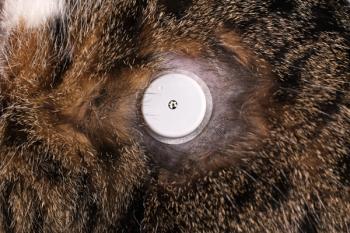
Hypoadrenocorticism in dogs (Proceedings)
Normal neural stimulation of the hypothalamus produces corticotropin-releasing hormone (CRH). Corticotropin-releasing hormone stimulates the release of adrenocorticotropic hormone (ACTH) from the anterior pituitary. ACTH exerts its effects on the adrenal cortex and stimulates the zona fasiculata to release cortisol, the zona reticularis to release androgens and the zona glomerulosa to release mineralocorticoids, but the primary effect of ACTH is on cortisol release.
Normal Physiology- Hypothalamus/Pituitary/Adrenal Axis
Normal neural stimulation of the hypothalamus produces corticotropin-releasing hormone (CRH). Corticotropin-releasing hormone stimulates the release of adrenocorticotropic hormone (ACTH) from the anterior pituitary. ACTH exerts its effects on the adrenal cortex and stimulates the zona fasiculata to release cortisol, the zona reticularis to release androgens and the zona glomerulosa to release mineralocorticoids, but the primary effect of ACTH is on cortisol release. Cortisol provides a negative feedback to ACTH and CRH. Glucocorticoids are involved in many normal physiologic responses in the body.
Mineral corticoid release from the zona glomerulosa is primarily mediated by the renin- angiotensin-aldosterone system and only minimally by ACTH. Renin is released from the juxtaglomerular apparatus of the kidney into circulation as a result of sympathetic stimulation, hypotension, hyponatremia and hypochloremia. Renin then converts circulating angiotensinogen to angiotensin I. Angiotensin converting enzyme in the pulmonary vascular endothelium converts angiotensin I to angiotensin II. Angiotensin II then stimulates aldosterone secretion from the zona glomerulosa. In the absence of ACTH, atrophy of the zona glomerulosa can occur and mineralocorticoid deficiency result. Mineralocorticoids are primarily involved in water and electrolyte balance.
Causes
Spontaneous Hypoadrenocorticism
This is a disease that results from dysfunction or destruction of the majority of the adrenocortical tissue. Most cases arise from primary adrenocortical failure resulting in signs of glucocorticoid and mineralocorticoid deficiency. The adrenal disease is termed idiopathic but is suspected to be immune mediated in origin. Destruction of cells results in atrophy of the gland.
Atypical Hypoadrenocorticism
There is an atypical form of hypoadrenocorticism, that occurs when there is atrophy of the zona fasciculata alone, resulting in hypocortisolism without the concurrent lack of aldosterone. This results in vague clinical signs and a disease that is more challenging to diagnose.
Secondary Hypoadrenocorticism
Less commonly, abnormalities can result in reduced secretion of ACTH. Loss of ACTH has the potential to cause atrophy of the adrenal cortices and impairing secretion of glucocorticoids alone, which is termed secondary adrenocortical failure. This also results in signs of glucocorticoid deficiency without the concurrent signs of mineralocorticoid deficiency.
Iatrogenic Adrenal Insufficiency
This occurs with use of a drug that decreases adrenal function. The most common drugs associated with this condition include glucocorticoids, used chronically, which are withdrawn too quickly and drugs to treat hyperadrenocorticism (mitotane and trilostane). Most commonly there is a hypocortisolemia, but rarely with mitotane/trilostane there can be permanent necrosis of the adrenal glands, causing both mineralocorticoid and glucocorticoid deficiencies.
Relative Adrenal Insufficiency
This condition may occur in human patients, and there have now been some veterinary studies looking into whether it is recognized in our patients with sepsis. There is still controversy as to whether it truly exists.
In response to critical illness levels of circulating free cortisol generally increase, allowing increased levels to be achieved at sites of inflammation. During severe illness though, there are factors that can impair the normal corticosteroid response. This can be at the level of the pituitary, affecting stimulation of the adrenal glands, or at the level of the adrenals themselves, impairing cortisol production. In people some of these conditions include head injury, central nervous system depressants, pituitary infarction, adrenal hemorrhage and septicemia. A recent study has documented cases of dogs with sepsis that did not respond adequately to ACTH stimulation tests. These patients had systemic hypotension and decreased survival.
Spontaneous Hypoadrenocorticism
Clinical Presentation
Spontaneously occurring hypoadrenocorticism can occur in any breed but there may be an increased incidence in West Highland White Terriers, Great Danes, Nova Scotia Duck Tolling Retrievers, and Standard Poodles amongst other breeds. Females are affected more frequently and intact females have an even higher incidence. Affected dogs have been reported up to 14 years of age but the disease is more common in young and middle-aged dogs.
History
The history can be variable. The classic history is of waxing and waning lethargy, inappetence, vomiting and diarrhea that often responds to symptomatic treatment. There is often a stressful event that precipitates these episodes. Dogs may also present for weakness, polyuria, polydipsia, muscle wasting, regurgitation and seizures. These signs may be present for weeks to months. A more acute presentation may also occur in which dogs present in hypovolemic shock. These dogs may or may not have a history of more chronic signs. In acute disease anorexia, vomiting, diarrhea, melena and collapse are more common.
Clinical Findings
Clinical signs may be acute or chronic, and frequently wax and wane. Clinical signs may be vague, and are rarely pathognomonic for the disease, especially with the atypical form of the disease. Dogs may be weak, lethargic, have a poor coat or coat color change, muscle wasting, and abdominal pain. In a more acute presentation the dog may be laterally recumbent, with pale tacky mucous membranes, increased capillary refill, poor pulse quality, bradycardia and hypothermia. Less common clinical findings include severe hypoglycemia causing seizures, severe gastrointestinal hemorrhage, hepatopathy, renal failure, and megaesophagus.
Laboratory Findings
The most common finding on the CBC is a mild non-regenerative anemia. In many cases the absence of a stress leukogram is noted. This may result in lymphocytosis and eosinophilia. The classic electrolyte abnormalities are hyperkalemia, hyponatremia and hypochloridemia. These occur due to mineralocorticoid deficiency because of a lack of aldosterone and its effects on the renal tubules. Increased BUN and creatinine are primarily prerenal. It is possible that these dogs can develop acute renal failure if their prerenal factors (hypovolemia, hypotension) are not addressed in a timely fashion. Liver enzymes may be normal or mildly increased likely due to poor perfusion of the liver. Hypoglycemia may also be seen with cortisol deficiency. A mild hypercalcemia is fairly common and the exact cause unknown. A mild hypoalbuminemia is also seen frequently and likely due to increased losses in the intestinal tract. A metabolic acidosis occurs secondary to decreased hydrogen ion excretion (aldosterone deficiency), poor tissue perfusion (generates lactic acid) and decreased renal excretion of acids.
Diagnostic Imaging
Thoracic radiographs might reveal microcardia, decreased diameter of the caudal vena cava and megaesophagus. On abdominal ultrasound, adrenal glands might be normal or occasionally, small in size.
Electrocardiography
Hyperkalemia can cause several electrocardiographic changes including bradycardia, a spike T wave, and increased duration of the QRS, decreased to absent P wave, prolonged P-R interval and atrial standstill.
Endocrine Tests
ACTH Stimulation Test
The ACTH stimulation test is the only test available to diagnose this disease. It is important to note that a single baseline cortisol is inadequate for diagnosis and may be normal in dogs with hypoadrenocorticism. Blood for a baseline cortisol is taken followed by administration of synthetic ACTH given IV or IM at 5 mcg/kg with a second sample obtained an hour later. There should be no stimulation and cortisol levels are often less than 2.0 µg/dl. Note: Remember that with adrenal tumors it is possible to get results that are subnormal, generally due to tumors that secrete intermediary hormones. The overall clinical picture must be considered with each case.
Endogenous ACTH
This test can be performed to differentiate primary form secondary hypoadrenocorticism. In primary hypoadrenocorticism ACTH is increased because of a lack of feedback. With secondary hypoadrenocorticism ACTH is low to undetectable.
Aldosterone
Aldosterone can also be used as a differentiating test but is more difficult to interpret than endogenous ACTH. Aldosterone is measured prior to and 1 hour after synthetic ACTH is administered as described above. In normal dogs aldosterone should increase two-fold. In dogs with primary hypoadrenocorticism, there will be little to no increase in aldosterone. In cases of secondary hypoadrenocorticism, aldosterone concentrations will be variable and basal and post-ACTH levels may be undetectable or subnormal.
Aldosterone-to-Renin and Cortisol-to ACTH ratios
Measurement of cortisol:ACTH ratio and aldosterone :rennin ratio has been proposed as an alternative to traditional diagnostic testing. These tests are performed on serum, with only one sample necessary. There is a lack of availability of the rennin and aldosterone assays, making this diagnostic option currently impractical in a clinical setting.
Treatment
In hypovolemic shock it is important to address hypotension and hypovolemia. Typically this is done with shock rates (80 – 90 ml/kg/hr) of crystalloid fluids until fluid deficits are corrected. Sodium chloride is frequently used. If bradycardia and moderate to severe hyperkalemia (> 8.0 mEq/L) is present then 10% calcium gluconate can be administered at 0.5 ml/kg over 15 minutes to help maintain a normal membrane potential. Regular insulin (0.2 U/kg) and dextrose 1g/kg can be given IV to move potassium intracellularly. Sodium bicarbonate at 2 mEq/kg can be given as an alternative. Fluid diuresis will aid in elimination of potassium through the kidneys.
Glucocorticoids should be given as soon as possible. Dexamethasone sodium phosphate is recommended because it will not interfere with the ACTH stimulation test. Initially high doses of glucocorticoids are used. Dexamethasone sodium phosphate is given at 0.5 mg/kg initially. This can be followed up by hydrocortisone sodium succinate at 0.5 mg/kg/hr CRI or prednisolone sodium succinate 1 mg/kg BID to TID. Parenteral glucocorticoids are given until the dog is no longer vomiting and eating regularly then switched to prednisone at 0.5 mg/kg BID. Maintenance doses of glucocorticoids can be as low as 0.1 mg/kg/day but it might take several weeks until the dog can be safely weaned to this dose.
Mineralocorticoids are not necessary in an acute crisis but should be given as soon as a mineralocorticoid deficiency is diagnosed. Options for mineralocorticoid replacement are desoxycorticosterone pivalate (DOCP) or fludrocortisone acetate. DOCP is given at 2.2 mg/kg SC or IM injection every 2 to 6 weeks. Monitoring electrolytes every 1 to 2 weeks will help determine dosing intervals. Initially IM administration of DOCP might be preferred due to possibilities of poor perfusion in acute disease. Fludrocortisone is an alternative in a dog that can take oral medications. Fludrocortisone is given at 0.02 mg/kg once to twice daily. DOCP has very little glucocorticoid activity so supplementation with glucocorticoids is necessary. Fludrocortisone can occasionally be administered without glucocorticoids but in both instances glucocorticoids should be given initially and then tapered to the lowest dose necessary to maintain appetite and normal activity levels while minimizing signs of glucocorticoid excess. Sodium and chloride often remain low despite normal potassium. Salt can be supplemented to help normalize sodium and chloride but is usually not necessary long term.
H2 antagonists and sucralfate are commonly administered in acute hypoadrenal crisis particularly if there is hematemesis or melena that may be due to gastrointestinal ulceration. Glucose is supplemented as needed for hypoglycemia.
Prognosis
The disease carries a good to excellent prognosis with treatment. Many dogs with atypical hypoadrenocorticism eventually develop mineralocorticoid deficiency so electrolytes should be checked periodically.
References available on request.
Newsletter
From exam room tips to practice management insights, get trusted veterinary news delivered straight to your inbox—subscribe to dvm360.




